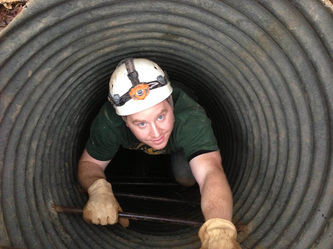Also, identifying people could be a significant challenge. They may be covered in mud, wet, hypothermic, or even dead. They also may be located behind a pile of rocks from the main passage. I think trying to identify a victim in a cave would be a full research project without any sort of robotic movement. Also, humans brains are wired to do detection effectively.
I would suggest that improving communications would be a more manageable goal. Alternatively, mechanical aids in lifting/moving a person in rough terrain would also be very helpful.
Caving Rescue Product Design Questions. Thanks guys.
Moderator: Norm Berg
21 posts
• Page 2 of 2 • 1, 2
-

caver.adam - NSS Hall Of Fame Poster
- Posts: 345
- Joined: Feb 8, 2012 12:26 pm
- Primary Grotto Affiliation: Louisville Grotto
Re: Caving Rescue Product Design Questions. Thanks guys.
caver.adam wrote:Communication is a big problem. Basically, (anything over VHF) is only effective for a few feet beyond line of sight. In a cave with many turns you may require dozens, hundreds, or even thousands of repeater stations for high frequency communications.
It would not take thousands of repeaters. As a bit of possibly entertaining information, CMAP gives the maximum depth and the maximum width of a breadth first search of the survey data. I am not up to date with the data, but as of 2009, it took 247 survey shots to reach the deepest point in Lechuguilla. For Paxton, a 7.3 mile maze cave in Virginia, it takes 127 shots. This would be for communicating to a rescue already in progress.
A search would take more repeaters. For that, see Rich Breisch's book, Lost in a Cave.
- Bob Thrun
- NSS Hall Of Fame Poster
- Posts: 322
- Joined: Jul 18, 2006 12:50 pm
Re: Caving Rescue Product Design Questions. Thanks guys.
I am an electronic engineer in New Zealand. I have been thinking over the years about trying to design a system that would work deep underground for communication with cavers both regular trip cavers and those being rescued and also for trapped miners.
Even very low frequency radio does not have great range through rocks. Magnetic fields work better but they need a huge loop above ground and underground so not very practical. I wonder how far acoustic shock would travel deep in a cave. Think of a cordless impact driver attached to the rock at the entrance and a portable one to carry into the cave. With a sensitive microphone to receive and the impact driver or hammer drill sending a string of acoustic shocks through the rock effectively doing slow speed morse code.
I am also a ham radio operator and there are some amazing new very slow speed digital modes like FT8 that use a PC sound card to detect and decode signals way below the noise floor. A modern smartphone has a lot of processing capability to decode weak signal audio. It is now possible to send audio data signals over 500km under the sea but that is far more homogenous than a cave.
What I have no idea about is how far will an acoustic impact travel underground - not at human hearing levels but with with just a few micro-watts at the receiving end. I am sure that there will be some level of impact energy that will reach deep underground (think explosion) but for this to be practical it needs to work with the few hundred Nm of impact that you can get from a small cordless impact driver. The end goal would be a base unit with cellular or satellite modem that you attach to the rock at the entrance or above a cave by finding a rock crack to screw a fastener to or drilling a small hole. The portable unit would be about 1kg for the impact driver and electronics plus cordless drill battery (0.5kg) plus an Android phone as the terminal. Cavers could send short text messages to phones anywhere that have been preprogrammed into the base unit and receive replies. If this has already been tried and failed "nothing new under the sun" please just politely tell me I am wasting my time. I have only just joined this forum to ask these questions so please gently correct me if I haven't followed the right protocol or you will scare me off.
Even very low frequency radio does not have great range through rocks. Magnetic fields work better but they need a huge loop above ground and underground so not very practical. I wonder how far acoustic shock would travel deep in a cave. Think of a cordless impact driver attached to the rock at the entrance and a portable one to carry into the cave. With a sensitive microphone to receive and the impact driver or hammer drill sending a string of acoustic shocks through the rock effectively doing slow speed morse code.
I am also a ham radio operator and there are some amazing new very slow speed digital modes like FT8 that use a PC sound card to detect and decode signals way below the noise floor. A modern smartphone has a lot of processing capability to decode weak signal audio. It is now possible to send audio data signals over 500km under the sea but that is far more homogenous than a cave.
What I have no idea about is how far will an acoustic impact travel underground - not at human hearing levels but with with just a few micro-watts at the receiving end. I am sure that there will be some level of impact energy that will reach deep underground (think explosion) but for this to be practical it needs to work with the few hundred Nm of impact that you can get from a small cordless impact driver. The end goal would be a base unit with cellular or satellite modem that you attach to the rock at the entrance or above a cave by finding a rock crack to screw a fastener to or drilling a small hole. The portable unit would be about 1kg for the impact driver and electronics plus cordless drill battery (0.5kg) plus an Android phone as the terminal. Cavers could send short text messages to phones anywhere that have been preprogrammed into the base unit and receive replies. If this has already been tried and failed "nothing new under the sun" please just politely tell me I am wasting my time. I have only just joined this forum to ask these questions so please gently correct me if I haven't followed the right protocol or you will scare me off.
- peter munn
- Infrequent Poster
- Posts: 2
- Joined: Jan 25, 2022 5:06 pm
Re: Caving Rescue Product Design Questions. Thanks guys.
Hey Peter,
Have you had a look at this web page?:
https://caves.org/section/commelect/spelonic.html
You can also contact the NSS Comm. Section here:
https://caves.org/section/commelect/drupal/
These folks are very helpful. I hope this helps!
Jim
Have you had a look at this web page?:
https://caves.org/section/commelect/spelonic.html
You can also contact the NSS Comm. Section here:
https://caves.org/section/commelect/drupal/
These folks are very helpful. I hope this helps!
Jim
Jim Coke
-

chac - Frequent Poster
- Posts: 91
- Joined: Sep 5, 2005 7:42 am
- Location: Near Quintana Roo
- NSS #: 26442
Re: Caving Rescue Product Design Questions. Thanks guys.
Hi Peter,
Interesting concept, thanks for sharing. I don't know if this has been tried before. Give it a shot!
This is not my area of expertise at all, so take my thoughts with a grain of salt. I think you'll run into some issues not all that dissimilar to traditional cave radio. Vibration conduction will surely be affected by geology, and particularly by changes in geology between the transmitter and receiver. Variations in rock, soil, voids, etc. Also I assume acoustic vibrations will propagate quite differently in limestone vs marble vs granite vs lava etc. Like radio waves do (or don't).
The other challenge you'll likely have to overcome is interference, both man-made and natural (seismic). We can't call this RFI, so maybe AVI (Acoustic Vibration Interference)? I can only imagine what other sources of noise/vibration will be picked up by a very sensitive acoustic receiver, and then the processor will need to do its magic separating the signal from the noise. Like we found with VLF, this may affect the surface station (receiving) a lot more than the underground station.
Really to be sure any system like this will work in the event of a cave rescue, it will need to be pre-tested in specific locations in that cave. Otherwise, as with traditional cave radio, you'll be taking a chance on whether or not comms will work when you most need them. Good luck!
Interesting concept, thanks for sharing. I don't know if this has been tried before. Give it a shot!
This is not my area of expertise at all, so take my thoughts with a grain of salt. I think you'll run into some issues not all that dissimilar to traditional cave radio. Vibration conduction will surely be affected by geology, and particularly by changes in geology between the transmitter and receiver. Variations in rock, soil, voids, etc. Also I assume acoustic vibrations will propagate quite differently in limestone vs marble vs granite vs lava etc. Like radio waves do (or don't).
The other challenge you'll likely have to overcome is interference, both man-made and natural (seismic). We can't call this RFI, so maybe AVI (Acoustic Vibration Interference)? I can only imagine what other sources of noise/vibration will be picked up by a very sensitive acoustic receiver, and then the processor will need to do its magic separating the signal from the noise. Like we found with VLF, this may affect the surface station (receiving) a lot more than the underground station.
Really to be sure any system like this will work in the event of a cave rescue, it will need to be pre-tested in specific locations in that cave. Otherwise, as with traditional cave radio, you'll be taking a chance on whether or not comms will work when you most need them. Good luck!
-

NZcaver - Global Moderator
- Posts: 6367
- Joined: Sep 7, 2005 2:05 am
- Location: Anchorage, Alaska
- Name: Jansen
- NSS #: 50665RL
21 posts
• Page 2 of 2 • 1, 2
Return to Communications and Electronics Section Forum
Who is online
Users browsing this forum: No registered users

